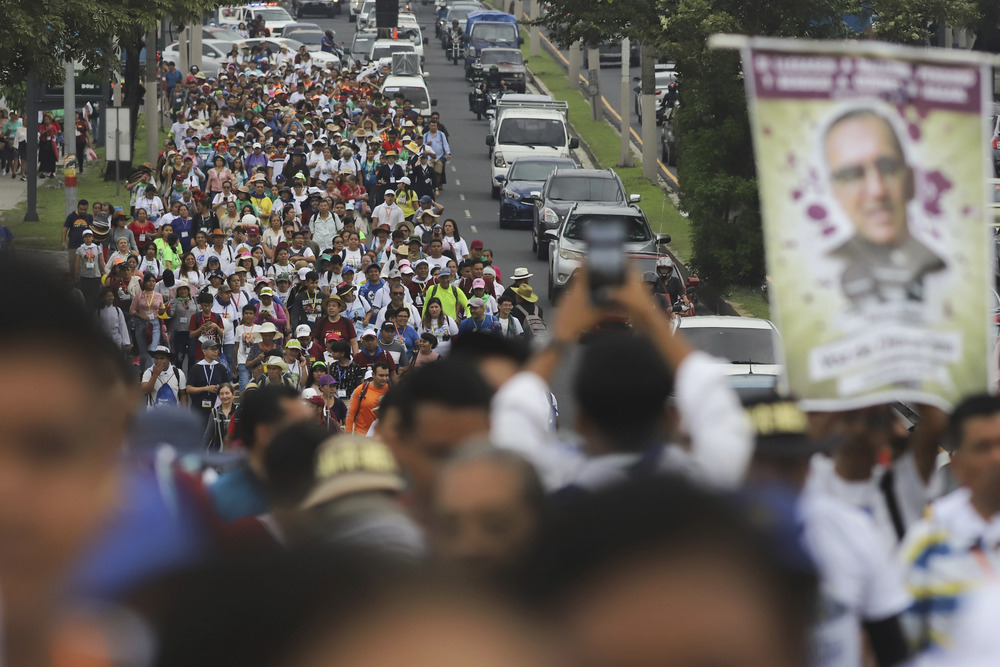
A religious procession honors St. Oscar Arnulfo Romero in San Salvador, El Salvador, Aug. 1. Romero was assassinated on March 24, 1980, while celebrating Mass. (AP/Salvador Melendez)
It’s as if Joyce Valencia could still hear St. Oscar Romero’s voice.
“I met him when I was a little girl,” the 61-year-old Salvadoran said. “We used to gather around our radio with our grandma to listen to him. And, even now, listening to him encourages us to move forward.”
For a few years now, Valencia has joined the yearly pilgrimage that kicks off in El Salvador each Aug. 1 to honor Romero, who was named a saint by Pope Francis in 2018.
According to the committee that organizes the event, up to 3,000 pilgrims will cover 160 kilometers (100 miles) in three days, traveling from San Salvador, the capital, to Ciudad Barrios, where Romero was born in 1917.
Already known to many as “St. Romero of the Americas,” San Salvador’s archbishop was beloved among the working class and poor for defending them against repression by the army. But he was loathed by conservative sectors who saw him as aligned with leftist causes as the country descended into a 1980-1992 civil war.
Romero was murdered as he celebrated Mass on March 24, 1980, in a hospital chapel. The day before his assassination, he sent a blunt message to the country’s military in his Sunday homily: “In the name of God and this suffering people, I implore you, I order you, in the name of God, to cease the repression.”
Romero’s influence continues to resonate in this Central American country where thousands of lives have been destroyed through decades of extortion and murder committed by the gangs.
Since March 2022, President Nayib Bukele’s security forces have cracked down harshly on gangs, arresting more than 81,000 people suspected of criminal involvement without due process. Human rights groups say innocent people are also being detained.
“Monsignor Romero is of great importance during these times, under the regime, as many human rights are being violated and very few institutions advocate for them,” said Wilbert Sánchez, 21, a university student whose aunt was detained during Bukele’s crackdown and freed after one year, due to lack of evidence against her.
“I think if he (Romero) were here, things would be different,” Sánchez said. “He would make a change, as he did in the past, when he tried to intercede for the peasants and others affected by the government.”
Soon after a 5 a.m. Mass, Sánchez joined dozens in the pilgrimage, his third since friends invited him to tag along in 2022.
“You can feel a very special connection during the journey,” Sánchez said. “What encourages me the most is faith. And learning more about our country’s only saint.”
Advertisement
Romero’s pilgrimage was first organized by Catholic leaders in 2017, when the archbishop would have turned 100.
The route, said Cardinal Gregorio Rosa Chávez, who was Romero’s disciple and friend, is meant to unite the saint’s “tomb”, San Salvador, with his “crib”, Ciudad Barrios.
“He was the most beloved and hated man of his time,” Rosa Chávez said. “It was exceptional to watch him in his struggles, his anguish, his doubts and his tribulations until he gave his life on the altar.”
According to the cardinal, Salvadorans participate in the pilgrimage for three main reasons: being at peace with Romero after discovering that government criticisms of him back in the 1980s were “slanders”, to thank him for miracles or favors, and to simply enjoy the spiritual experience of the journey.
Each pilgrimage has a theme.
“This year’s mark the 500th anniversary of our encounter with Christ,” said Fr. Rev. Santos Belisario during a recent news conference. “The first Mass that took place in El Salvador calls us to remember the first priests and bishops who arrived in Salvadoran territory, many of whom valiantly fight for the dignity and rights of the Indigenous people.”
During the journey to Ciudad Barrios, pilgrims not only pray, but also participate in dances and cultural activities in the towns where locals offer shelter and food. Religious leaders from across the country join the celebrations as well.
Abraham Hernández, 87, has completed the procession times. “I hope that my age and body won’t fail me this time,” he said.
The Salvadoran man never met Romero personally but is grateful for his political stances. “He even gave his life for us, so that we would have a better government,” Hernández said.
Joyce Valencia, too, feels nothing but gratitude. “I thank God for our saint,” she said. “He is our pastor and friend”.
She has asked many favors of Romero and he has granted them all, including a return to good health for a girl who had seemed destined for heart surgery.
“It’s a joy to attend this pilgrimage. To pray for our country,” Valencia said. “During these difficult times, he is like a ray of hope.”





